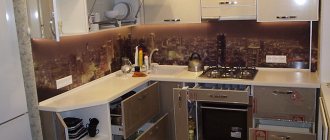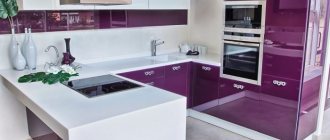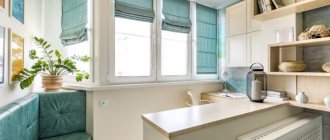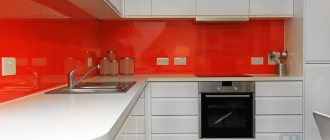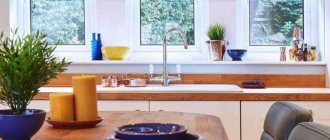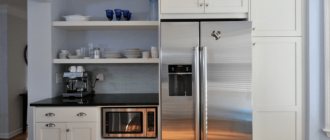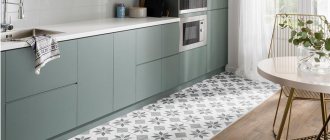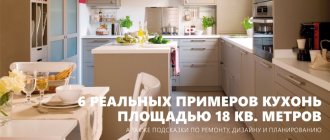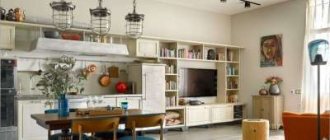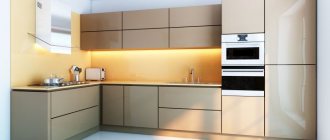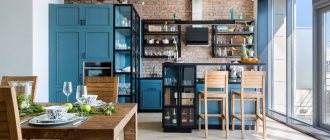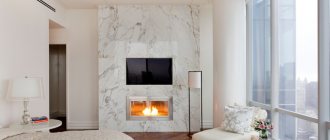A kitchen set is always notable for its facades; they play a fundamental role and create the overall style of the kitchen. For several years, the most popular material for making facades has been acrylic. The fashion for it came to Russia from Italy.
The material has proven itself on the positive side and has gained popularity. However, like any other material, acrylic has disadvantages.
Let's look at the features of acrylic facades and find out their main advantages.
What are acrylic facades?
The modern kitchen interior is increasingly decorated with furniture with acrylic fronts. The popularity of the material among designers is due to its bright gloss, which first of all catches the eye and gives the kitchen a special charm. The kitchen looks stylish and modern.
Given the nature of the production of parts, consumers are offered a wide selection of different shades of acrylic. Having such opportunities, you can decorate the kitchen area in any style. This explains the popularity of acrylic kitchens among designers.
In addition to the glossy finish, acrylic facades with a matte texture have recently begun to be produced. This design option has its advantages. The popularity of new acrylic is growing and will very soon reach the level of popularity of gloss.
As a rule, kitchens with acrylic facades are used to create classic kitchen interiors or a minimalist style. The most popular in these styles are glossy facades. Matte acrylic is used to create loft and hi-tech styles.
A kitchen with acrylic fronts will look equally original both in large kitchens with a dining area and in small rooms. Moreover, with its help you can visually expand the area. This technique is perfect for cramped Khrushchev-era kitchens.
It is important to choose the lightest colors of the facades and finish it in gloss. There is no need to be afraid of white tones; in the case of a small kitchen, warm shades of milky, cream cheese, and panna cotta colors will look especially advantageous. Bright gloss will visually expand the room, and the color of the kitchen will add warmth and light.
A mixture of two acrylic textures - glossy and matte facades - will look great. If the kitchen does not have the problem of small areas, you should give preference to a set whose lower sections will be made in a matte texture, and the upper tier in a glossy texture. At the same time, you can experiment with shades. For example, decorate matte sections in coffee color, and glossy sections in milky shades.
Acrylic film
The situation is somewhat different with film, or, more precisely, with decorative multilayer paper impregnated with absorbents and acrylic resin. This coating is applied to an MDF or chipboard board and fixed by hot pressing. The ends of the facade are covered with postforming or edging.
Advantages of the material:
- according to reviews, the strength and durability of such a film is much higher than PVC products, and accordingly, a linear meter of kitchen costs more;
- The film layer is 1 mm. However, it provides the same level of gloss as enamel or acrylic panel. The film is inferior to the slab in terms of strength and durability, and to some extent - in color fastness. It is protected to a lesser extent from ultraviolet radiation;
- At the same time, a linear meter of kitchen can cost more than the option with acrylic panels. The fact is that the film can be attached to curved facades, and this design is much more interesting;
- the color and shine of the film is in no way inferior to acrylic plastic: beige, milk, eggplant, black and white finish - the price does not change depending on the color. However, for pastel shades and white (milk), lavender and gray, it is recommended to select a material with a pearlescent sheen, and for intense saturated colors, including lilac, eggplant, black and white, with a maximum degree of gloss. It is worth noting that such deep colors as purple, eggplant or sea green are also good in mother-of-pearl.
The disadvantages of the product are less durability and lack of scratch resistance, so it is much easier to damage the film.
Production technology
Acrylic kitchen facades are made from acrylic plates by sawing into pieces with the required parameters. Acrylic board, in turn, is manufactured using high-tech equipment by combining two components: MDF board and acrylic.
The acrylic layer is a plate approximately 1 mm thick that covers the MDF board. They are connected to each other by rolling. The temperature effect on the parts helps to achieve perfect adhesion of materials to each other.
Acrylic facades are divided into two types depending on the fastening of the acrylic plate:
- Double-sided - an acrylic board is attached to both sides of the MDF. Accordingly, the facades both inside and outside will be made of the same material and will be the same color.
- One-sided - fastening the acrylic plate only from the front side. The kitchen facades will be framed with colored acrylic only on the outside; on the other side there will be an MDF board. This method of constructing kitchen parts is usually resorted to in an effort to reduce the cost of the set. Visually, the kitchen will look the same as with double-sided processing, but its cost will be significantly lower. You can only notice the difference when you open the cabinet.
You can reduce the cost of a kitchen with acrylic facades by replacing the MDF board with a chipboard board. Externally, the kitchens will also not be different. At the same time, parts made from MDF are much stronger and will last longer.
The technology for manufacturing acrylic boards is available to only a few furniture factories in Russia due to the high cost and specificity of the equipment necessary for its creation. Other furniture factories work with ready-made raw materials. Creating a furniture set involves cutting a finished acrylic board into pieces of the required size. In this case, the edge plays a decisive role.
You can process the edges using two methods:
- Attaching a regular soft edge to the edge using low-temperature glue - this technology is most often used due to its ease of execution and accessibility. This edge framing does not require additional equipment and can be done by any craftsman in a furniture workshop.
- Laser edging is a more complex option, but also the most durable. The edge is soldered into the MDF board using a special laser. This method creates a feeling of integrity of the parts. After this treatment, the edge will not peel off, will not swell from moisture, and will not dry out near hot radiators in winter.
- Aluminum edge is the most durable option for making a facade, but this method is much more expensive.
Advice! When choosing a kitchen set with acrylic facades, you should give preference to laser edging; this will significantly extend the life of the kitchen set and ensure the proper appearance of all parts for the entire service life.
The basis of acrylic kitchen sets
The basis for any kitchen is not plastic, but wood or wood-based materials. MDF is most often used, since the advantages of the material far outweigh its disadvantages:
- MDF is much more resistant to moisture and temperature changes - this is ensured by manufacturing technology. Facades made of MDF and plastic do not deform over time and do not change color;
- MDF is a stabilized material that does not change its dimensions, so the doors will definitely not move, and the acrylic will not peel off. This is one of the main reasons that a linear meter of acrylic MDF furniture costs much more than its analogues;
- The plate is stronger, so it can only be damaged by a strong blow. For the same reason, furniture made from MDF is much more durable;
- the structure of the MDF panel does not affect the color of the product in any way: black and white facade, mint shade, milk color or silver metallic effect - any design options are possible.
Chipboard is used much less frequently. Of course, this material is more affordable, and a linear meter of such a kitchen will cost less. However, chipboard deforms much more strongly and quickly under the influence of moisture and steam and is much less durable. It is unprofitable to attach such an expensive and durable material as acrylic to it; it is better to use PVC film.
Advantages and disadvantages
Making a decision on the choice of material for a kitchen set is possible only after an objective assessment of the advantages and disadvantages.
Advantages:
- Long service life - kitchen sets with acrylic facades have good performance properties and last about 15–20 years. The gloss or matte finish will not wear off over time, and the color will not cease to be rich, since it is protected from ultraviolet rays and does not fade in the sun.
- Environmentally friendly - the production of acrylic facades does not involve the use of resins, carcinogens and other harmful substances. Operation is absolutely safe for people; the kitchen will not emit harmful toxic substances even when exposed to heat.
- Moisture resistance - thanks to the production technology of acrylic facades, the parts of the kitchen set are moisture resistant, they will not swell from dampness. Over time, even in an area where water is constantly present, mold will not form, since the water will not penetrate into the structure of the facades.
- Fire resistance - has good protection against thermal influences. Acrylic melts at a temperature of 160 degrees.
- Wide range - manufacturers offer a wide selection of shades. It will not be difficult to choose the desired color from such an assortment.
- Wear resistance - acrylic facades are impervious to impacts and sharp objects; it will not be easy to spoil the appearance of the kitchen. In addition, acrylic is protected from ultraviolet rays, so it will not fade over time.
- Ease of use - the material is easy to clean with any detergent, except abrasive powders. The texture does not allow dirt to penetrate inside, so when removing dirt from the facades, the kitchen will be spotlessly clean.
- Spectacular appearance - a unique version of the kitchen set. A unique glossy shine gives the kitchen a special charm. Such a kitchen will visually expand the room, and the glossy finish will beautifully reflect the sun's rays and fill the room with light.
Flaws:
- Cost - the price of a kitchen set with acrylic facades is an order of magnitude higher than other market offers, for example, plastic. Not every family can afford such luxury. However, you can consider options to reduce the cost by making parts from chipboard or using one-sided acrylic coating.
- Frequency of contamination - the glossy texture of acrylic will show drops, splashes and stains, something that cannot be avoided during the operation of the kitchen set. Such furniture requires daily care. You will have to wipe the facades frequently, and also rub them with a glass cleaner and a special rag. However, without abandoning acrylic facades, you can consider a matte structure that will hide imperfections.
Manufacturing materials
There are a number of requirements for the base under acrylic coating:
- smooth surface;
- dense structure;
- low porosity.
MDF fiberboard with a thickness of 16-18 mm fully fits the description.
Chipboard is considered a more affordable option in furniture production, but in this case such savings are questionable. Particle boards cannot boast of density, uniformity, and the front side contains irregularities.
What to choose - acrylic or plastic?
Acrylic facades are most often compared to plastic due to the similarity in appearance. However, these are completely different materials. Plastic can be described as a budget option for acrylic facades. When making a decision in favor of acrylic or plastic, it is worth assessing their differences.
- Acrylic coating is much more environmentally friendly than plastic - the composition of acrylic does not imply the presence of harmful components, so it will not emit toxic substances or unpleasant odors even when exposed to heat, which cannot be said about plastic.
- The glossy shine of acrylic is much brighter and has a mirror-like shine . Plastic, in turn, is much dimmer.
- The acrylic coating is resistant to high temperatures - melting occurs at a temperature of 160 degrees. Plastic emits toxic substances and odor already at 80 degrees, and melts at 140.
- The service life of acrylic is up to 20 years. Due to exposure to sunlight, plastic fades within a couple of years.
- Acrylic facades belong to the segment of expensive premium materials . Plastic is a budget option; the kitchen will cost relatively little.
So the difference is obvious. If the choice is not a financial issue, then preference should be given to acrylic facades. This kitchen is of higher quality and more reliable.
Acrylic colors for the kitchen - the key to a cozy interior
Modern acrylic panels have a wide range of colors. A variety of colors allows you to make the interior extraordinary.
White acrylic plastic for the headset is suitable for small spaces. Due to the strong reflection of light rays, the room becomes wider. But snow-white shades are very easily soiled, so the surfaces will have to be cleaned every day.
- Gray kitchen in the interior: photos, ideas for color combinations, kitchen design in gray tones
Combination of colors in the kitchen - which color is better to choose
- White kitchen with black countertop – contrast and harmony of colors in the interior, 110+ best photos of kitchens
Interesting! The gloss of glossy coatings is determined using a special scale. The shine of PVC film is rated at 70GLE, plastic at 80GLE, and acrylic facades at 90GLE to 95 GLE.
Furniture in black and white looks more unusual. To reduce cleaning, you can place white cabinets at the top and black ones at the bottom. On black ones, fingerprints will be less visible, but water drips will be stronger. Therefore, daily wiping will still be necessary.
White and black can be combined with any bright colors: green, blue, pink.
Bright red is now often used, but in combination with pastel colors: gray, gold, beige. The monotony quickly becomes boring due to the aggressiveness of the shade.
Yellow colors should also not always be made monochromatic, especially with bright tones. And the muted ones don’t need to be diluted; they will add freshness and light to the room.
For those who prefer neutral furniture, beige is suitable. It reflects the sun's rays strongly, almost like white, but is not very blinding. This will make it more comfortable to be in the room.
In addition to beige, all pastel colors reflect light well and can enlarge a room: blue, lilac, pale pink, etc.
Acrylic or painted facades?
Painted MDF is a popular material for making kitchen facades. This is done by applying special paint to MDF. The texture of the parts gives the impression of painted wooden parts.
The advantage of painted MDF over acrylic is an even wider palette of colors than is offered for acrylic facades. You can choose absolutely any shade to create your interior. However, this is the only significant advantage.
Facades made of painted MDF are susceptible to external influences, even minor ones. It is easy to leave a mark on the facade when hit or with a sharp object. The appearance of the kitchen does not last long as the paint will fade and fade within a couple of years.
Thus, acrylic facades are much stronger, more durable and cheaper. But if you want to create a unique interior design using an unusual palette, you should pay attention to painted facades.
Performance characteristics of acrylic coating
At first glance, acrylic coatings resemble enamel in appearance due to their smooth, glossy surface. Upon closer examination, it turns out that the shine is brighter, the colors are richer, and the furniture is warm and pleasant to the touch.
Italian craftsmen were the first to use acrylic for furniture finishing, after which the fashion for this material spread among furniture makers in other countries. Acrylic's predecessor, polymethyl methacrylate, was developed in Germany in the 1930s and was called "plexiglass." The substance is a polymer based on acrylic and methacrylic acid and is resistant to chemical influences from detergents and solvents.
Panels transform the kitchen and the overall appearance of the room
Acrylic kitchen facades are not afraid of moisture and high temperatures (the material is not flammable, and the melting point is 160°C), which allows them to be installed in close proximity to kitchen stoves and sinks.
Care
In exchange for numerous advantages, acrylic facades require proper care. In such a kitchen, both glossy and matte, splashes, drops and stains will be noticeable. You will have to clean the kitchen frequently. At least once a week, it is necessary to clean the surface of the facades from greasy marks, fingerprints and other contaminants using a soft microfiber cloth using grease-repellent gels.
It is worth noting that abrasive agents are absolutely contraindicated for this material. Cleaning should be done only with gentle products.
You will have to maintain the glossy shine daily. To do this, you need to use rags made of soft materials and products for glass and mirror surfaces that do not contain alcohol or acetone.
Thus, a kitchen with acrylic facades has numerous advantages compared to other materials. Its main feature is the increased requirement for care. However, reviews from real buyers on the Internet say that “the game is worth the candle.” The stylish, bright appearance of the kitchen and its practicality overshadow the disadvantages in the form of maintenance features and the high cost of the set.
Where to buy an acrylic kitchen in St. Petersburg?
Now you know how this fashionable coating differs from others, how best to care for acrylic facades and what our compatriots say about this furniture.
Do you want to purchase an “acrylic plastic” kitchen without overpaying? Then you are in the right place. Eurostyle is not an intermediary, but a manufacturing factory, which is why our kitchen prices are the most reasonable. Look through the photos from our catalog - there are quite a few acrylic kitchen sets here, so you have plenty to choose from! You can calculate the approximate cost of your order directly on the website.
Acrylic facades in the kitchen (photo examples)
Comparison of acrylic and glass
See also
Solid wood kitchen furniture: all the pros and cons
In terms of external characteristics and some other aspects, acrylic is more reminiscent of glass than plastic. But in both cases, the superiority is on the side of the material in question.
By making furniture from it, in comparison with glass, the consumer receives the following advantages:
- multiple superiority in strength;
- significantly improved impact resistance;
- increased security;
- acrylic is approximately 50% lighter than a glass product of similar dimensions;
- polymer is easier to process, which expands the possibilities for designers;
- If the furniture is transparent, the resulting scratches can be easily polished.
As you can see, the total domination of our today's hero. But to buy such furniture, you will have to shell out a decent amount of money.
Whether to use acrylic furniture or not is up to each individual. But acrylic can be used as an idea to create your own business. If interested, read more detailed material at this link.
Coating method
Acrylic kitchen fronts are made in several ways. The coating can be applied only to the front side of the MDF sheet with a thickness of 16-18 mm or to both sides. The thickness of the acrylic layer is up to 3 mm.
A more expensive version is also produced, a solid panel 4 mm thick in an aluminum frame. Despite the cost, this design will decorate the interior in a high-tech style. The combination of a smooth, shiny acrylic surface and a metallic aluminum edge will perfectly fit into a discreet, functional environment.
Acrylic plastic for the kitchen is applied to the facade as follows:
- Acrylic material is laid on a 16mm MDF board.
- The slab is fed into an automated press, where the film is applied under simultaneous high temperature and pressure.
- The slab is being cut.
- The edge is cleaned, acrylic film or PVC film is applied to the end part.
The manufacturing technology prevents peeling of the coating during operation.
Acrylic should be a quality material to use in the kitchen
